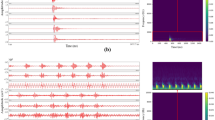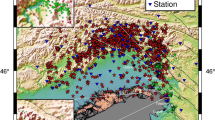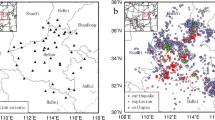Abstract
Microseismic monitoring system is one of the effective methods for deep mining geo-stress monitoring. The principle of microseismic monitoring system is to analyze the mechanical parameters contained in microseismic events for providing accurate information of rockmass. The accurate identification of microseismic events and blasts determines the timeliness and accuracy of early warning of microseismic monitoring technology. An image identification model based on Convolutional Neural Network (CNN) is established in this paper for the seismic waveforms of microseismic events and blasts. Firstly, the training set, test set, and validation set are collected, which are composed of 5250, 1500, and 750 seismic waveforms of microseismic events and blasts, respectively. The classified data sets are preprocessed and input into the constructed CNN in CPU mode for training. Results show that the accuracies of microseismic events and blasts are 99.46% and 99.33% in the test set, respectively. The accuracies of microseismic events and blasts are 100% and 98.13% in the validation set, respectively. The proposed method gives superior performance when compared with existed methods. The accuracies of models using logistic regression and artificial neural network (ANN) based on the same data set are 54.43% and 67.9% in the test set, respectively. Then, the ROC curves of the three models are obtained and compared, which show that the CNN gives an absolute advantage in this classification model when the original seismic waveform are used in training the model. It not only decreases the influence of individual differences in experience, but also removes the errors induced by source and waveform parameters. It is proved that the established discriminant method improves the efficiency and accuracy of microseismic data processing for monitoring rock instability and seismicity.
摘要
微震监测系统作为深部矿山地压监测的有效手段之一,其作用原理是分析微震事件包含的力学 参数,为岩体稳定性分析提供最准确的信息。准确地辨识微震事件与爆破事件决定了微震监测技术预 警的时效性与准确性。鉴于微震事件和爆破事件的地震波形具有不同的特征,本文建立了一种基于卷 积神经网络的微震事件和爆破事件辨识模型。首先将采集到的微震与爆破事件波形分别组成训练 集(微震爆破事件各5250 个)、测试集(微震爆破事件各1500 个)以及验证集(无标签的微震爆破事件各 750 个),将分类得到的数据集进行预处理并在CPU 模式下输入至构建好的卷积神经网络模型中进行训 练。结果显示训练集中微震事件识别的准确率为99.46%,爆破事件识别的准确率为99.33%,验证集 中微震事件识别的准确率为100%,爆破事件识别的准确率为98.13%。与其他机器学习方法进行对比, 该方法拥有较高的辨识准确率。逻辑回归模型与人工神经网络模型在相同测试集下的准确率仅为 54.43%和67.90%。通过绘制并对比三种模型的ROC 曲线,可以看出由于使用原始波形训练模型,CNN 在辨识微震与爆破事件中表现出了绝对的优势。这不仅减少了个体经验差异的影响,而且消除了提取 震源参数和波形参数过程中产生的误差。证明了本文所建立的微震与爆破事件辨识方法提高了微震数 据处理的速度和精度。
Similar content being viewed by others
References
ZHANG Chu-xuan, LI Xi-bing, DONG Long-jun, MA Ju, HUANG Lin-qi. Analysis of microseismic activity parameters pre- and post roof caving and early warning [J]. Chinese Journal of Rock Mechanics & Engineering, 2016, 35: 3214–3221. DOI: https://doi.org/10.13722/j.cnki.jrme.2015.0928.
XU Nu-wen, LIANG Zheng-zhao, TANG Chun-an, DAI Feng, ZHOU Zhong, SHA Chun. Three-dimensional feedback analysis of rock slope stability based on microseismic monitoring [J]. Chinese Journal of Rock Mechanics and Engineering, 2014, 33: 3093–3014. DOI: https://doi.org/10.13722/j.cnki.jrme.2014.s1.071.
MONDAL D, ROY P N S. Fractal and seismic b-value study during dynamic roof displacements (roof fall and surface blasting) for enhancing safety in the longwall coal mines [J]. Engineering Geology, 2019, 253: 184–204. DOI: https://doi.org/10.1016/j.enggeo.2019.03.018.
GONG Feng-qiang, SI Xue-feng, LI Xi-bing, WANG Shan-yong. Experimental investigation of strain rockburst in circular caverns under deep three-dimensional high-stress conditions [J]. Rock Mechanics and Rock Engineering, 2019, 52(4): 1459–1474. DOI: https://doi.org/10.1007/s00603-018-1660-5.
MA Tian-hui, TANG Chun-an, TANG Shi-bin, KUANG Liang, YU Qun, KONG De-qing, ZHU Xu. Rockburst mechanism and prediction based on microseismic monitoring [J]. International Journal of Rock Mechanics and Mining Sciences, 2018, 110: 177–188. DOI: https://doi.org/10.1016/j.ijrmms.2018.07.016.
MA Chun-chi, LI Tian-bin, ZHANG Hang, JIANG Yu-peng, SONG Tao. A method for numerical simulation based on microseismic information and the interpretation of hard rock fracture [J]. Journal of Applied Geophysics, 2019, 164: 214–224. DOI: https://doi.org/10.1016/j.jappgeo.2019.03.014.
DOU Lin-ming, CAI Wu, CAO An-ye, GUO Wen-hao. Comprehensive early warning of rock burst utilizing microseismic multi-parameter indices [J]. International Journal of Mining Science and Technology, 2018, 28: 767–774. DOI: https://doi.org/10.1016/j.ijmst.2018.08.007.
MA Ju, DONG Long-jun, ZHAO Guo-yan, LI Xi-bing. Discrimination of seismic sources in an underground mine using full waveform inversion [J]. International Journal of Rock Mechanics and Mining Sciences, 2018, 106: 213–222. DOI: https://doi.org/10.1016/j.ijrmms.2018.04.032.
ZHANG Peng-hai, YANG Tian-hong, YU Q L, XU Tao, SHI Wen-hao, LI Shu-cai. Study of a seepage channel formation using the combination of microseismic monitoring technique and numerical method in Zhangmatun iron mine [J]. Rock Mechanics and Rock Engineering, 2016, 49: 3699–3708. DOI: https://doi.org/10.1007/s00603-016-1007-z.
AMINZADEH F, TAFTI T A, MAITY D. An integrated methodology for sub-surface fracture characterization using microseismic data: A case study at the NW Geysers [J]. Computers & Geosciences, 2013, 54: 39–49. DOI: https://doi.org/10.1016/j.cageo.2012.10.015.
ZHAI Hong-yu, CHANG Xu, WANG Yi-bo, YAO Zhen-xing. Inversion for microseismic focal mechanisms in attenuated strata and its resolution [J]. Chinese Journal of Geophysics-Chinese Edition, 2016, 59: 3025–3036. DOI: https://doi.org/10.6038/cjg20160825. (in Chinese)
YANG Cheng-xiang, LUO Zhou-quan, TANG Li-zhong. Study on rule of geostatic activity based on microseismic monitoring technique in deep mining [J]. Chinese Journal of Rock Mechanics and Engineering, 2007, 26(4): 818–824. DOI: https://doi.org/10.1016/S1872-2067(07)60020-5.
DONG Long-jun, SUN Dao-yuan, LI Xi-bing, DU Kun. Theoretical and experimental studies of localization methodology for AE and microseismic sources without pre-measured wave velocity in mines [J]. IEEE Access, 2017, 5: 16818–16828. DOI: https://doi.org/10.1109/ACCESS.2017.2743115.
DONG Long-jun, SHU Wei-wei, LI Xi-bing, HAN Guang-jie, ZOU Wei. Three dimensional comprehensive analytical solutions for locating sources of sensor networks in unknown velocity mining system [J]. IEEE Access, 2017, 5: 11337–11351. DOI: https://doi.org/10.1109/ACCESS.2017.2710142.
DONG Long-jun, SHU Wei-wei, HAN Guang-jie, LI Xi-bing, WANG Jian. A multi-step source localization method with narrowing velocity interval of cyber-physical systems in buildings [J]. IEEE Access, 2017, 5: 20207–20219. DOI: https://doi.org/10.1109/ACCESS.2017.2756855.
DONG Long-jun, LI Xi-bing, MA Ju, TANG Li-zhong. Three-dimensional analytical comprehensive solutions for acoustic emission/microseismic sources of unknown velocity system [J]. Chin J Rock Mech Eng, 2017, 36: 186–197. DOI: https://doi.org/10.13722/j.cnki.jrme.2015.1765.
DONG Long-jun, LI Xi-bing, TANG Li-zhong, GONG Feng-qiang. Mathematical functions and parameters for microseismic source location without pre-measuring speed [J]. Chinese Journal of Rock Mechanics and Engineering, 2011, 30: 2057–2067. DOI: https://doi.org/10.1016/j.cnsns.2011.01.018.
FRANTTI G E, LEVEREAULT L A. Auditory discrimination of seismic signals from earthquakes and explosions [J]. Bulletin of the Seismological Society of America, 1965, 55: 1–25. DOI: https://doi.org/10.1016/0014-4835(75)90080-9.
BOOKER A, MITRONOVAS W. An application of statistical discrimination to classify seismic events [J]. Bulletin of the Seismological Society of America, 1964, 54: 961–971. DOI: https://doi.org/10.1596/1813-9450-4793.
TAYLOR S R. Analysis of high-frequency Pg/Lg ratios from NTS explosions and western US earthquakes [J] Bulletin of the Seismological Society of America, 1996, 86: 1042–1053. http://library.sciencemadness.org/lanl2_a/lib-www/la-pubs/00326269.pdf.
MALOVICHKO D. Discrimination of blasts in mine seismology [C]// Deep Mining. 2012: 161–171. DOI: https://doi.org/10.36487/ACG_rep/1201_11_malovichko.
JIANG Wen-wu, YANG Zuo-lin, XIE Jian-min, LI Jia-fu. Application of FFT spectrum analysis to identify microseismic signals [J]. Science & Technology Review, 2015, 33: 86–90. DOI: https://doi.org/10.3981/j.issn.1000-7857.2015.02.013.
DOWLA F U. Neural networks in seismic discrimination [J]. Nato Asi, 1995, 303: 777–789. DOI: https://doi.org/10.1007/978-94-011-0419-7_41.
BENBRAHIM M, DAOUDI A, BENJELLOUN K, IBENBRAHIM A. Discrimination of seismic signals using artificial neural networks [C]// The Second World Enformatika Conference, WEC’05. Istanbul, Turkey, 2005, http://citeseerx.ist.psu.edu/viewdoc/summary?doi=10.1.1.106.144.
ZHAO Guo-yan, MA Ju, DONG Long-jun, LI Xi-bing, CHEN Guang-hui, ZHANG Chu-xuan. Classification of mine blasts and microseismic events using starting-up features in seismograms [J]. Transactions of Nonferrous Metals Society of China, 2015, 25: 3410–3420. DOI: https://doi.org/10.1016/S1003-6326(15)63976-0.
MULLER S, GARDA P, MULLER J D, CANSI Y. Seismic events discrimination by neuro-fuzzy merging of signal and catalogue features [J]. Physics and Chemistry of the Earth, Part A: Solid Earth and Geodesy, 1999, 24: 201–206. DOI: https://doi.org/10.1016/S1464-1895(99)00019-8.
ORLIC N, LONCARIC S. Earthquake—explosion discrimination using genetic algorithm-based boosting approach [J]. Computers & Geosciences, 2010, 36: 179–185. DOI: https://doi.org/10.1016/j.cageo.2009.05.006.
DONG Long-jun, LI Xi-bing, XIE Gong-nan. Nonlinear methodologies for identifying seismic event and nuclear explosion using random forest, support vector machine, and naive Bayes classification [J]. Abstract and Applied Analysis, 2014: 459137. DOI: https://doi.org/10.1155/2014/459137.
VALLEJOS J A, MCKINNON S D. Logistic regression and neural network classification of seismic records [J]. International Journal of Rock Mechanics and Mining Sciences, 2013, 62: 86–95. DOI: https://doi.org/10.1016/j.ijrmms.2013.04.005.
DONG Long-jun, WESSELOO J, POTVIN Y, LI Xi-bing. Discrimination of mine seismic events and blasts using the fisher classifier, naive bayesian classifier and logistic regression [J]. Rock Mech. Rock Eng, 49(1): 183–211. DOI: https://doi.org/10.1007/s00603-015-0733-y.
SHANG Xue-yi, LI Xi-bing, MORALES-ESTEBAN A, CHEN Guang-hui. Improving microseismic event and quarry blast classification using artificial neural networks based on principal component analysis [J]. Soil Dynamics and Earthquake Engineering, 2017, 99: 142–149. DOI: https://doi.org/10.1016/j.soildyn.2017.05.008.
HUBEL D H, WIESEL T N. Receptive fields, binocular interaction and functional architecture in the cat’s visual cortex [J]. The Journal of physiology, 1962, 160: 106–154. DOI: https://doi.org/10.1113/jphysiol.1962.sp006837.
FUKUSHIMA K. Neocognitron: A self-organizing neural network model for a mechanism of pattern recognition unaffected by shift in position [J]. Biological Cybernetics, 1980, 36: 193–202. DOI: https://doi.org/10.1007/BF00344251.
LI Zhong-mei, GUI Wei-hua, ZHU Jian-yong. Fault detection in flotation processes based on deep learning and support vector machine [J]. Journal of Central South University, 2019, 26(9): 2504–2515. DOI: https://doi.org/10.1007/s11771-019-4190-8.
TIVIVE F H C, BOUZERDOUM A. A new class of convolutional neural networks (SICoNNets) and their application of face detection. [C]// Proceedings of the International Joint Conference on Neural Networks, IEEE, 2003. https://ieeexplore.ieee.org/document/1223742.
SHAO Jie, QIAN Yong-sheng. Three convolutional neural network models for facial expression recognition in the wild [J]. Neurocomputing, 2019, 355: 82–92. DOI: https://doi.org/10.1016/j.neucom.2019.05.005.
KÖLSCH A, AFZAL M Z, EBBECKE M, LIWICKI M. Real-time document image classification using deep CNN and extreme learning machines [EB/OL] 2017-11-03. https://arxiv.org/pdf/1711.05862v1.pdf DOI: https://doi.org/10.1109/ICDAR.2017.217.
SHARAD J, SURAJ S, NITIN K. First steps toward CNN based source classification of document images shared over messaging app [J]. Signal Processing: Image Communication, 2019, 78: 32–41. DOI: https://doi.org/10.1016/j.image.2019.05.020.
CHEN Tong, JIANG Ying, JIAN Wang, QIU Lan-xin, LIU Huan, XIAO Zhao-lin. Maintenance personnel detection and analysis using mask-rcnn optimization on power grid monitoring video [J]. Neural Processing Letters, 2020, 51(2): 1599–1610. DOI: https://doi.org/10.1007/s11063-019-10159-w.
SONG Shi-jin, QUE Zhi-qiang, HOU Jun-jie, DU Sen, SONG Yue-feng. An efficient convolutional neural network for small traffic sign detection [J]. Journal of Systems Architecture, 2019. DOI: https://doi.org/10.1016/j.sysarc.2019.01.012.
GOODFELLOW I, BENGIO Y, COURVILLE A. Deep learning(Vol.1) [M]. Cambridge: MIT Press, 2016: 326–366.
ESTRACH J B, SZLAM A, LECUN Y. Signal recovery from pooling representations [C]// Proceedings of the International Conference on Machine Learning (ICML). 2014: 307–315. http://www.oalib.com/paper/4115463#.X2QRMHot2Uk.
DONG Long-jun, WESSELOO J, POTVIN Y, LI Xi-bing. Discriminant models of blasts and seismic events in mine seismology [J]. Int J Rock Mech Min Sci, 2016, 86: 282–291. DOI: https://doi.org/10.1016/j.ijrmms.2016.04.021.
Author information
Authors and Affiliations
Corresponding author
Additional information
Conflict of interest
DONG Long-jun, TANG Zheng, LI Xi-bing, CHEN Yong-chao, and XUE Jin-chun declare that they have no conflict of interest.
Foundation item: Projects(51822407, 51774327, 51664016) supported by the National Natural Science Foundation of China
Rights and permissions
About this article
Cite this article
Dong, Lj., Tang, Z., Li, Xb. et al. Discrimination of mining microseismic events and blasts using convolutional neural networks and original waveform. J. Cent. South Univ. Technol. 27, 3078–3089 (2020). https://doi.org/10.1007/s11771-020-4530-8
Received:
Accepted:
Published:
Issue Date:
DOI: https://doi.org/10.1007/s11771-020-4530-8




